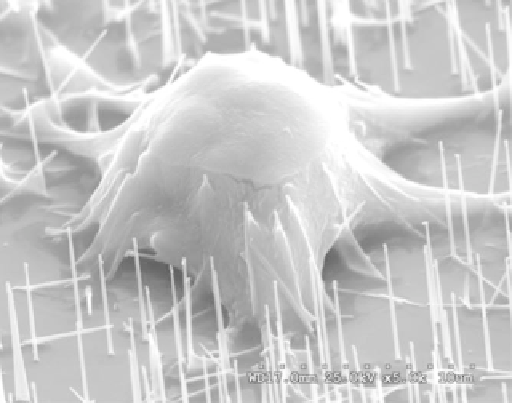Biomedical Engineering Reference
In-Depth Information
suffered from several drawbacks. Due to their large sizes, they can morpho-
logically or chemically perturb the cellular environment. They can bleach, that
is, become ineffectual after exposure to light. Nanoparticles, in contrast, can be
coated with a passivation layer or specialized shell that limits direct interaction
with the surrounding media, hence greatly minimizing bleaching and intra-
cellular generation of reactive oxygen species. Present challenges include
developing inorganic nanoparticles with enhanced voltage sensitivity and
orchestrating plasmonic enhancement of existing optical reporters. It should
also be feasible to develop inorganic nanoparticles with voltage sensitivity,
verify their biocompatibility, and identify and validate routes to targeted
delivery. New organic non-linear voltage probes and multifunctional nano-
probes that can locally report not only voltage, but also chemical species (e.g.
calcium, neurotransmitters, etc.), local temperature or ionic environment are
the focus of current research efforts.
Semiconductor nanowires can detect specific intracellular biomolecules,
perform small-molecule drug screening, detect intracellular signaling, and also
deliver drugs and genetic material into the cell. This nanotube spearing
necessitates an oscillating magnetic field to spear the nanotubes, followed by a
static field to drive them inside the cells. Figure 4.2 shows how these nanowires
are non-fatal to the cell. The cell remains functional for a few days and can even
differentiate from stem cells. The mechanism of cellular engulfment of the
nanorods and subsequent normal function remains to be explored.
12
Silicon nanowires have been implemented with either field effect transistor-
type active sensors or metal nanoelectrodes for in vitro neural sensors. The
d
n
4
t
3
n
g
|
0
n
3
.
Figure 4.2
Scanning electron microscope (SEM) image of mouse embryonic stem
cells penetrated by Si nanowires on a Si substrate. The scale bar represents
10 mm.
12
(Reprinted by kind permission of the American Chemical Society.)

